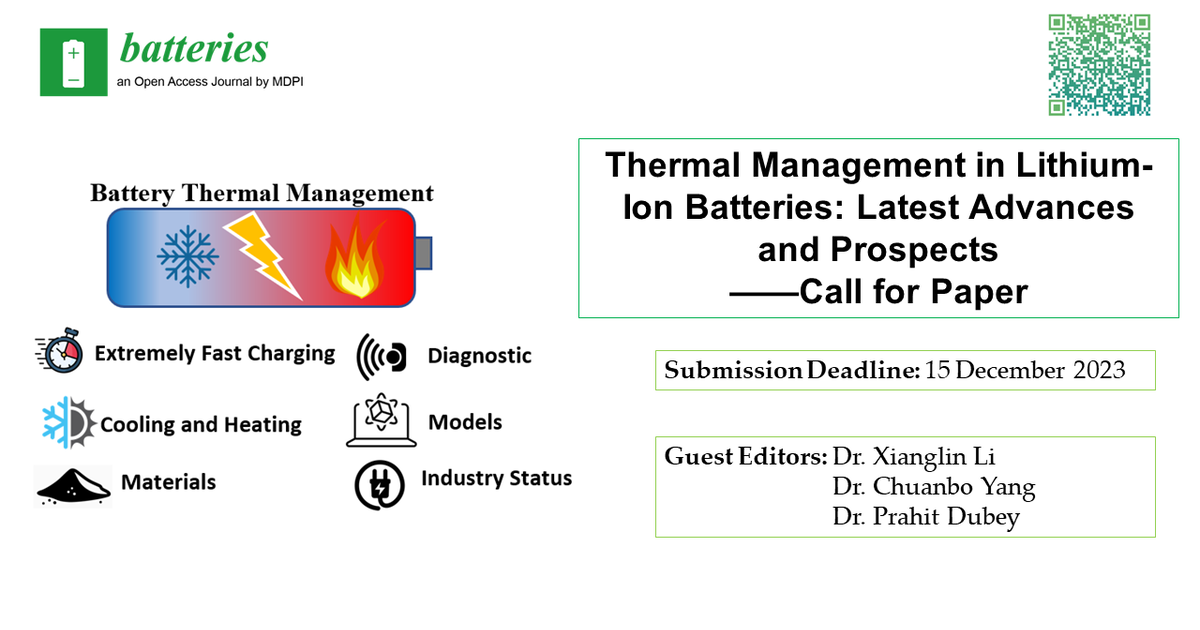Thermal Management in Lithium-Ion Batteries: Latest Advances and Prospects
A special issue of Batteries (ISSN 2313-0105). This special issue belongs to the section "Battery Performance, Ageing, Reliability and Safety".
Deadline for manuscript submissions: 15 May 2025 | Viewed by 31807

Special Issue Editors
Interests: fuel cells; Li-O2 batteries; battery thermal management; heat and mass transfer in porous media
Interests: Li-ion battery; multiphysics modeling; battery safety and thermal management; fluid dynamics and control
Special Issue Information
Dear Colleagues,
The rapidly expanding battery market presents an urgent requirement for reliable, efficient, and affordable thermal management and protection solutions. These solutions are crucial to improve the cycle life and performance, as well as to mitigate the risk of thermal runaway and catastrophic failures in battery packs. Addressing these pressing needs is of the utmost importance for the power electronics, electric vehicle, and battery industries. By enhancing the safety of battery packs, we can facilitate the widespread adoption of batteries in energy-intensive applications such as electric vehicles and grid-scale energy storage systems. In addition, a higher battery cycle life improves the long-term cost–benefit of a battery electric vehicle or energy storage system. Advanced thermal management strategies can also improve performance, such as fast charging and aggressive discharges across a large temperature band, which further supports battery technology adaptation. Therefore, there is a critical imperative to develop robust, efficient, and cost-effective thermal management strategies that ensure the performance, integrity, and stability of battery systems.
In light of the rapid growth witnessed in the electric vehicle and rechargeable battery markets, this Special Issue, entitled “Thermal Management in Lithium-Ion Batteries: Latest Advances and Prospects”, presents an opportune platform to explore diverse thermal management technologies. It specifically focuses on their application in battery and electronics systems for transportation applications, including passenger cars, trucks, buses, locomotives, boats, aircraft, and beyond, encompassing both established industry practices and emerging solutions for future advancements. By examining conventional approaches alongside cutting-edge innovations, this timely collection of articles aims to address the evolving demands of the field and foster insights into effective thermal management strategies.
We encourage contributions from diverse global stakeholders to foster a comprehensive and inclusive dialogue. Valuable insights and expertise from academic institutions, industry organizations, and national laboratories are highly valued and encouraged. Both experimental studies and numerical simulations are welcomed. Topics of interest for publication include, but are not limited to:
- Assessment of industry approaches and emerging advancements;
- Single-phase cooling (passive, direct active, indirect active, and hybrid);
- Multi-phase cooling (phase change materials, evaporative cooling, immersion/submerged cooling);
- Innovative cooling materials and structures;
- Advanced sensors, thermal control, and fault detection;
- Battery materials and designs with improved thermal properties;
- Strategies to mitigate thermal runaway and propagation;
- Cutting-edge models to gain insights into thermal-related degradation mechanisms;
- New mechanistic models to understand degradation caused by thermal issues;
- Fusion of machine learning algorithms to enhance the precision and efficiency of detection and prediction;
- Extreme conditions such as extremely fast charge and low temperatures.
Dr. Xianglin Li
Dr. Chuanbo Yang
Dr. Prahit Dubey
Guest Editors
Manuscript Submission Information
Manuscripts should be submitted online at www.mdpi.com by registering and logging in to this website. Once you are registered, click here to go to the submission form. Manuscripts can be submitted until the deadline. All submissions that pass pre-check are peer-reviewed. Accepted papers will be published continuously in the journal (as soon as accepted) and will be listed together on the special issue website. Research articles, review articles as well as short communications are invited. For planned papers, a title and short abstract (about 100 words) can be sent to the Editorial Office for announcement on this website.
Submitted manuscripts should not have been published previously, nor be under consideration for publication elsewhere (except conference proceedings papers). All manuscripts are thoroughly refereed through a single-blind peer-review process. A guide for authors and other relevant information for submission of manuscripts is available on the Instructions for Authors page. Batteries is an international peer-reviewed open access monthly journal published by MDPI.
Please visit the Instructions for Authors page before submitting a manuscript. The Article Processing Charge (APC) for publication in this open access journal is 2700 CHF (Swiss Francs). Submitted papers should be well formatted and use good English. Authors may use MDPI's English editing service prior to publication or during author revisions.
Benefits of Publishing in a Special Issue
- Ease of navigation: Grouping papers by topic helps scholars navigate broad scope journals more efficiently.
- Greater discoverability: Special Issues support the reach and impact of scientific research. Articles in Special Issues are more discoverable and cited more frequently.
- Expansion of research network: Special Issues facilitate connections among authors, fostering scientific collaborations.
- External promotion: Articles in Special Issues are often promoted through the journal's social media, increasing their visibility.
- e-Book format: Special Issues with more than 10 articles can be published as dedicated e-books, ensuring wide and rapid dissemination.
Further information on MDPI's Special Issue policies can be found here.







